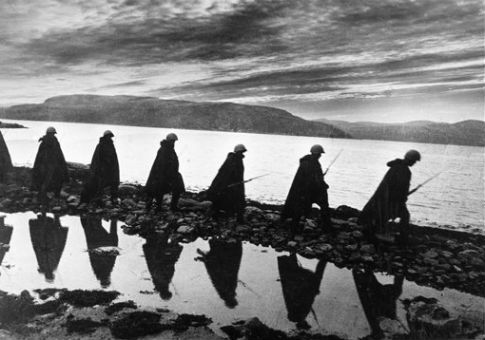Historian Robert Kirchubel’s Atlas of the Eastern Front 1941-1945 is a volume of immense detail, of interest for professionals and passionate amateur historians. After a brief but useful outline of Eastern Front history during World War II, Kirchubel jumps straight into the 1941 invasion of the Soviet Union by the Nazis, better known as Operation Barbarossa. As they had against previous adversaries, the Nazis used a combination of speed and mobility to outflank, encircle, and then crush unsuspecting Soviet forces.
The maps tell the tale. We see Wehrmacht forces smashing their way through Soviet weak points and then linking up to destroy surrounded strongpoints. Accompanying each chart is a short and useful history written by Kirchubel to ensure that readers understand the strategic context. To readers unfamiliar with the history of World War II (few of whom, admittedly, would start their education with this specialist’s tome), the visual story suggests Moscow could not possibly escape Nazi domination. But the author reminds us that "Between September and October, at Kiev and Viazma-Bryansk, 1.3 million Soviet troops marched into captivity while half a million died in battle. Almost no other nation could sustain two million casualties in four weeks, but in October and November the Soviets were able to send 1.5 million new troops to take their place.’’ Near-limitless manpower would eventually win the day for Stalin.
Kirchubel also takes time to examine the bureaucratic and strategic failures of the Nazi war effort, focusing on Hitler’s delusions and the inefficient resourcing of capable units. In explaining the Wehrmacht failure to take Moscow, Kirchubel suggests four key Nazi failures: "troop exhaustion, personnel and materiel attrition, anemic logistics and the continued inability to settle on attainable objectives.’’ Historian Andrew Roberts has documented that the overextension of the Nazis stemmed in part from the perverse ideology of the Nazi leadership. Hitler especially was convinced that the racial superiority of the Germans would allow them to conquer territory swiftly and with a kit wholly unsuitable to the unforgiving Russian landscape. Thus did the flower of Hitler’s Aryan race freeze to death by the thousands.
Following the Nazi retreat from Moscow, the atlas gives insight into other battles that shaped the early years of the war. Those interested in Stalingrad will be especially gratified by Kirchubel’s three separate charts on the battle and his broader examination of Operation Uranus, which allowed Soviet forces to regain the initiative on the Eastern Front.
By the summer of 1943, Germany’s fate was sealed. This is evidenced by a frontline July 1943 chart, which shows 12 Soviet army groups and a number of Soviet armies attacking an increasingly fragile line of Wehrmacht formations. Further charts show how Wehrmacht attempts to counter-attack (colored in blue) were overwhelmed by Soviet countering movements (an endless sea of, appropriately, red). With each passing day, the initiative becomes more obviously locked in the Soviet favor.
By summer’s end 1944, Hitler’s forces had been all but annihilated. Wehrmacht army groups are severed into ramshackle armies and then into regiments. With their collapse, the Nazi war effort increasingly rested on the courageous but hopeless efforts of individual commanders and their men. These accounts—of holdouts challenging numerically-superior attackers—are impressive, as tales of courage in the face of certain death inevitably are.
Looking at the charts and reading of the huge numbers of those killed and wounded, we are reminded that Hitler did not simply massacre millions of innocents, but indeed dispatched millions in pursuit of delusional military objectives. This volume is a fine, detailed visual reference to one of the darkest times and places to have ever been a human being.
